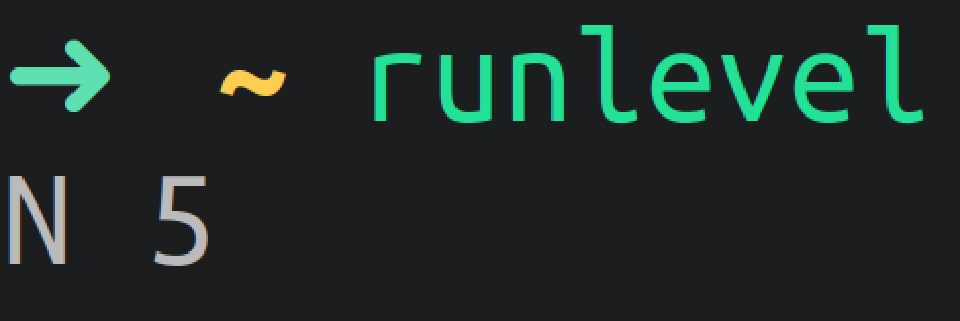Linux - System Startup and Shutdown
Published on

Contents
Introduction
In this post I’ll explain with detail how Unix uses initd or systemd to manage the boot/shutdown process: runlevels, targets, and how to run a script/program at certain points like boot or shutdown.
We can check the startup log with dmesg as it displays the system boot information. If we put a peripheral and the system does not start, this is where we look. A similar tool is journalctl -f.
Startup Commands
shutdown: Put the system in Maintenance mode. It allows scheduling maintenance by notifying users with a maintenance message. It can also be used to reboot. Does atelinit 1.For example:
shutdown +5 "The system is going to shut down"
halt: Puts the OS in the minimum state. Leaves CPUs with almost no task. Rest state without cutting off the power.poweroff: Sends an ACPI message to the BIOS that forces the power off.insserv: Utility that no longer exists and allows, at startup, to execute different programs. Now, crons or systemd services/timers are used instead.
Runlevels
A runlevel is the mode in which the OS booted, and there are seven boot levels in total.
Running runlevel shows which runlevel was the last used and which is using now. The number that appears on the left is the previous runlevel (if an N appears, there was none), and the one on the right is the current one.

The OS can be configured to start in any of these modes:
0: Stop status (shuts down the system completely).- Shut down the OS, is to boot the OS in a mode. Manage the completion of programs.
- If this mode is set by default, the computer starts up and shuts down. A bad joke.
1: Single user mode. It is used to do very rough administration tasks.- In a compromised system the first thing to do is to expel all users. The +1 mode manages the OS in such a way that it cuts off-network access and only allows physical access to one user. This is why it is used on compromised systems.
- Adding new hardware to the system configuration or suspicion of hardware failure.
- Administrative tasks such as update some applications, perform system backups or manage quotas.
2: Multi-user mode.3: Multi-user mode with command-line access.4: Same as 3. Not used. It was intended for future uses.5: Same as 3 but also allows graphic session IF YOU HAVE IT, else is the same as 3.6: Restart the system.- If it is set to be the default runlevel, the system boots and restarts continuously. Another bad joke.
telinit command allows you instantly switch between levels.
inittab file had the configuration for which level was to run at boot, but has now been replaced by systemd’s feature set-default.
Startup systems
SysVinit
- The BIOS is in charge of verifying that the integrity of the peripherals and hardware is in a safe state.
- Then load the Bootloader (it is in a partition of the hard disk and stores the information of the partitions to boot)
- After, the kernel is started in RAM, and it calls
init. initis the first process and loads the most basic things (rcS.d). Things like the clock, udev, mounting the filesystem, checking for errors, starting daemons, enabling peripherals…- It also checks the runlevel (
rcX.dwith X from 0 to 6), and depending on this, it starts some things or others. - The console (
getty) is started.
The files in /etc /rcS.d / are always executed. And depending on the runlevel we are in, the rc1, rc5… programs are loaded.
That is, if I am in runlevel 5, the programs in the rc5 directory will be executed.
Example
I want to start Spotify at startup (startup), put the Spotify startup script in init.d, and then depending on the runlevel at which we want it to run, we would make a symbolic link in the rcX to the script init.d.
These scripts start with an S (Start) or a K (Kill) and a number after that indicates the priority (from 01 to 99).
If you want Spotify to start in runlevel 2, you should put S in rc2, but if you change to runlevel 3 or 4, you should put K.
If we have two numbers with the same priority number, it is executed first in alphabetical order.
There is a Debian 6 command that does all of this:
update-rc.d /path/script start 90 2 3 4 5. stop 0 1 6
Where 90 is the priority, but this has to be calculated.
With Debian 7 it is done with insserv.
All of the above of the “update” that was passed by parameter, is now added as a header within the script. In the header you don’t have to assign a priority because it is managed by something called facilities:
- $local_fs
- $network
- $named
- $portmap
- $remote_fs
- $syslog
- $time
- $all: Have all the dependencies.
Systemd
Red Hat creates systemd. Many systems adopt it in exchange for init, and others reject it.
An advantage of systemd compared to init.d (the traditional way) is that it loads the processes that would be those of rcS.d and rcX.d in parallel.
Systemd instead of calling scripts, it calls them units, and they can be: services, mount points (instead of /etc/fstab), devices, sockets and targets (runlevel).
Instead of calling the runlevels by their numbers, they use:
runlelel0.target | poweroff.target |
runlevel1.target | rescue.target |
runlevel2.target | multi-user.target |
runlevel3.target | multi-user.target |
runlevel4.target | multi-user.targetgraphical.target |
runlevel5.target | reboot.target |
Systemd service
If you want to make a systemd startup script, create a myscriptd.service file in /lib/systemd/system/.
Once the service is located in that directory, we can enable the service with:
systemctl enable myscript
Example - Getting the weather
This script will always get the weather of the specified location and send it to a file, in the specified directory. The file will have as a filename the date of that day.
Service /lib/systemd/system/weatherd.service:
[Unit]
Description=Get the weather
After=network.target network-online.target
Requires=network-online.target
[Service]
RemainAfterExit=false
ExecStart=/usr/bin/weather "Spain" /root
[Install]
WantedBy=multi-user.target
Script /usr/bin/weather:
date=$(date +%Y%m%dT%H%M%S)
curl wttr.in/$1 > $2/$date
Once those files are in their directories and the script has execution permissions, we can enable the service:
systemctl enable weatherd
The
RemainAfterExitset to false, is due to the script only executing once. If it was set to true, the service would still be activated even when the script has finished a while ago.
Common commands
To see active units:
systemctlTo see installed units:
systemctl list-unit-filesTo see units that have failed:
systemctl --failedTo view SSH dependencies:
systemctl list-dependencies ssh.serviceTo see what parameters a unit has:
systemctl show cron.serviceTo view boot messages:
journalctl -bTo view new messages:
journalctl -fTo view new messages for a drive:
journalctl -u
| SysVinit | Systemd | |
|---|---|---|
| Start a service | service cron start | systemctl start cron.service |
| Enable a service | chkconfig cron on | systemctl enable cron.service |
| Check if a service is enabled | chkconfig cron | systemctl status cron.service |
| Check runlevel | runlevel | systemctl get-default |
| Change runlevel | telinit 1 | systemctl isolate runlevel1.target |
| Change default runlevel | (before was done with inittab file) | systemctl set-default graphical.target |
There is a parameter in systemd to specify when a script is to run (timer). The difference between a timer and a cron, is that the timer can be resource-specific at boot, which cron doesn’t.